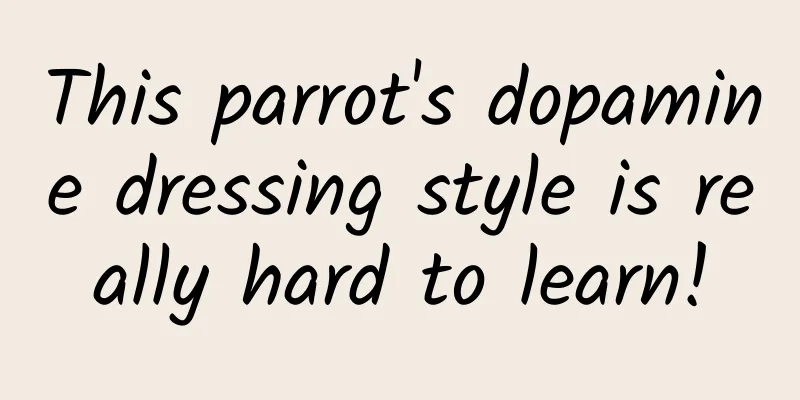This parrot's dopamine dressing style is really hard to learn!

|
The gateway to the eastern and western hemispheres on the meridian, the tropical ocean paradise of the southern hemisphere - thanks to the publicity by major travel agencies around the world, Fiji has become a world-class choice for honeymoon trips , and is also the most well-known of the many South Pacific island countries. Who doesn’t love the sea, the sun, and the beach? | pixabay.com But many people don’t know that this country, which is made up of hundreds of islands, has many unique species, such as the colorful national bird, the Kula parrot. The colorful national bird The national emblem of Fiji depicts the most abundant crops in the region, such as sugar cane, coconuts and bananas. A dove holding an olive branch symbolizes peace (getting rid of colonial rule is not easy). On the shield is an ancient canoe, indicating that this is an ancient maritime country . With vast seas and jungles, Fiji's rich native flora and fauna have many unique species . Fiji national emblem | Simi Tukidia / wiki commons Fiji's territory consists of 332 islands, of which only one-third are inhabited all year round, and nearly 90% of the population lives on the two large islands of Viti Levu and Vanua Levu. Fiji is located in the tropics, and the main islands are covered with lush forests, green grass, and blooming flowers, making it a bird-watching destination for enthusiasts; the blue sea and sky, white sand and coconut trees, and the colorful corals and colorful tropical fish in the offshore waters attract divers . The Coral Coast is located on Viti Levu, the largest island in Fiji. There is a Kula Eco Park (Kula WILD Adventure Park) here, which has a large aviary and breeding program for native birds . This ecological park is named after the national bird, the Kula parrot. Such a fancy guy | JJ Harrison / wiki commons The Kula parrot is called Kula in Fijian, collared lory in English, and its scientific name is Vini solitaria. It also has a more formal name in Chinese, called " green-collared honeyeater ". The beautiful scarlet feathers of the Green-collared Lorikeet were once treasured by locals for use in ceremonial garments and as cushion trimmings . Although Fijians now make cushions from wool instead of feathers, they still call the decorative trimmings on cushions "kula". A high-quality floor mat made by locals from pandanus and parrot feathers in 1900, now in the collection of the Honolulu Museum of Art | Hiart / wiki commons Blue toes and yellow beak, green clothes and green collar The Green-collared Lorikeet is of average size, not small but not too big, just a little bigger than the most common budgie - about 20 cm long and weighing 75-85 grams. But when it comes to color matching, let alone comparing it to birds, even comparing it to colorful flowers, it is more colorful . Their face and abdomen are bright red, and the dark purple forehead and top of the head are like a stylish and sultry hat. The back and wings are green, and the brighter emerald green patch on the neck is like a separate collar. The lower abdomen and legs are blue-purple, the beak is orange-yellow, and the iris is reddish-brown. "What do you know? This is called dopamine dressing!" | Dirk / wiki commons Male and female Green-collared Lorikeets look similar, but the female has a lighter purple cap. Juveniles are more different, with darker colors, purple stripes on the upper abdomen and chest, brown beaks, and light brown irises. Although this high-profile feather is particularly eye-catching and flamboyant in the monotonous urban buildings, it is an excellent camouflage in the rainforest environment. The bright feather color blends magically with flowers and dappled light, helping the Green-collared Lorikeet to hide cleverly among the leaves and blend into the jungle habitat. "I'm a big red flower (trying to fit in)" | Mike's Birds / wiki commons In Oceanic literature, lorikeets symbolize brightness that can give people spiritual strength . People love the colorful and shiny parrot feathers just as they love beeswax and red and yellow minerals. An ancient ballad translates as "Colorful lorikeets climbed up the casuarina trees/drying their feathers in the sun/the children of Degakawa...all shining brightly." Coincidentally, Ni Heng of the Eastern Han Dynasty also praised parrots for their "bright brilliance of the fire virtue." It seems that ancient people in both the northern and southern hemispheres had similar views on the bright feathers of parrots. Green-collared lorikeets are lively and active , flying from one bush to another in pairs or small groups, and occasionally dozens of them fly in groups, making noises on branches full of flowers. Unlike the familiar species of parrots that imitate the sound of human voices, their noisy and piercing calls are used not only for internal communication but also to deter predators and food competitors. The color of the feathers is annoying to the eyes, the sound is annoying to the ears...too noisy! | Steve Snodgrass / wiki commons Pick the beauty and explore the red flowers The Green-collared Lorikeet is endemic to Fiji, and the Lorikeet family to which it belongs is the only type of bird that can collect nutritious pollen . The pollen grains of flowering plants have oil droplets on their outer wall, which is both a waterproof "oil cloth raincoat" and an "oil-based glue" that can stick the pollen grains to the smooth beaks of birds and other pollinators. These oil molecules are thick and sticky and difficult to digest, which can prevent them from being eaten by most pollinating animals. However, nectar parrots have their own tricks to deal with the outer wall. They drink a lot of nectar first and then swallow the pollen. The pollen grains are soaked in a stomach full of sugar water and expand and crack, releasing substances that can be absorbed. The clever eaters thus obtain precious nutrients. "Is there pollen here? Brush some down!" | Mike's Birds / wiki commons Hidden in the orange-yellow hooked beak of the Green-collared Lorikeet is a flexible, slender, finger-like tongue with a layer of brush-like protrusions. This brush-like tongue structure facilitates sucking nectar and picking up pollen from flowers. **The pollen and nectar on each flower are very limited, so it is not easy to eat enough. **Collecting nectar, transporting nectar into the mouth, and swallowing it, each step must be extremely efficient and precise - this has even attracted many scholars to indulge in studying the biomechanics of their feeding. Nectar is sweet and fragrant, and its main nutrients are various sugars. These simple and easily digestible carbohydrates provide liquid energy for birds. However, eating nectar alone does not provide enough calories, and sufficient protein is needed to grow feathers and lay eggs, so they also eat some fruits and insects and seeds rich in fat and protein . "Now that the nectar is full, who will it harm next?" | Mike's Birds / wiki commons The Green-collared Lorikeet is the only Fijian rainforest bird that can adapt to urban life . The clever native birds have learned to take advantage of the convenient food sources in towns. In Suva during the day, if you stand still and hold your breath, you may see the Green-collared Lorikeet landing on a tree, perching or foraging in the canopy. They often gracefully penetrate into the flowers and hang upside down to suck nectar. When it comes to foraging, lorikeets have amazing cognitive abilities and memory, knowing which flowers will produce nectar when, how long it takes to refill, and remembering when and where they have collected nectar. They won't waste energy on empty flowers - this is a competition for survival rather than a game of leisure. Lorikeets are also a staple on Fiji postcards | Rainer Ebert Despite their cunning enjoyment of some pollen, lorikeets are reliable pollinators , and these tiny nectar-eating birds travel great distances each day, visiting a huge number of flowers. Many plants are also happy to provide nectarines with gourmet rewards and various conveniences - bird-pollinated flowers that rely on bird pollination have special shapes and colors (bright red or orange), bloom during the day, and are mostly funnel-shaped, bell-shaped, or tubular. The flowering period of these plants is also mostly in the dry season, which can prevent the warm and heavy rain from infecting the flowers with fungi or other diseases, and can also avoid the restrictions of rain on bird pollination activities. In Fiji, the favorite nectar plants of lorikeets are Erythrina and Flamewood. In the blooming season, the red flowers of Erythrina trees look like flying red birds, and the flowers of Flamewood are numerous and dense, with scarlet flowers, like flames burning on green leaves. Perhaps this can also make you understand more why the Green-collared Lorikeet finally "chose" this color combination. Blooming flamewood | Ввласенко / wiki commons Long chants and distant yearnings, mournful cries of emotion Although the Green-collared Lorikeet is not like other wild parrots that are coveted and privately raised by humans, and have to be separated from their flocks and partners, migrate thousands of miles, and be trapped in cages; nor is it like its counterparts that once lived in Tonga (there is fossil evidence) that became extinct due to early human colonization activities, they still have their own troubles. For the green-collared lorikeets, which depend on tropical flowering plants, the ecological environment is undoubtedly very important. They must synchronize their physiological rhythms precisely with the flowering period, and the flowering time is affected by the climate. Global warming and abnormal phenology will affect their cognition. "I memorized it again last semester, why did it change again this semester?" | Aviceda / wiki commons For the beautiful island paradise, people have taken strict environmental protection measures . Although agriculture (sugar industry), tourism and mining are the top three economic pillars of the local economy, the Fijian government strictly prohibits the use of any pesticides, charges high environmental pollution fees to miners and uses them for environmental governance and ecological restoration, and severely punishes illegal mining. Fiji's tourism agencies, Pacific Airlines and hotels on various islands are committed to environmentally friendly waste recycling methods. Overall, Fijians still maintain a natural and simple lifestyle and the habit of respecting flowers, plants and animals . Perhaps the simple diet and good attitude are part of the reasons why Fiji has become a "country of longevity and cancer-free." Light Fijian food | Geoffrey Rhodes Faced with global environmental crises such as global climate change, marine pollution, wildlife species decline, and tropical rainforest loss, the international community has established an international environmental treaty system to jointly address environmental issues . On March 29, 2008, Fiji and New Zealand took the lead in turning off the lights in response to the "Earth Hour" event, and 38 countries and regions in the world followed suit according to their time zones. As the most intelligent bird species, along with the corvids, the clever and outgoing parrots are learning to live with humans for the sake of population prosperity. But how should humans get along with these smart and beautiful creatures? It’s important to study how to share cities with wildlife . After all, the Earth belongs not only to us, but also to parrots and all other creatures, and there are still many unknown abilities of them that we need to learn. Author: Ditang Editor: Old Cat |
Recommend
Lao Duan said: Internet TV calls for innovation in user experience
In the nearly 60 years since television was inven...
What are the events of the 2022 Beijing Paralympic Winter Games? Will there be figure skating? Attached is an introduction to the major competition venues!
After Beijing's successful bid, it became the...
Closed-loop analysis of B-side channel operations
Industrial Internet is making efforts to penetrat...
It's not just about launching a new LOGO. Why is Alibaba Cloud trying so hard to accelerate its internationalization?
A few years ago, an analyst predicted that "...
Learn these 7 techniques, and even beginners can play Douyin in minutes
Recently, I often see complaints about Douyin in ...
Strong Crossing the Pass + New World 2 sets of courses are extremely powerful and rare courses
Strong Crossing the Pass + New World 2 sets of co...
15 days to boost store traffic, applicable to all restaurants, a must-learn to break through the bottleneck of order volume
15 days to boost store traffic, applicable to all...
From ad images to landing pages, 14 tips to improve conversions
This article is a summary of the book "The B...
China's mobile payments are changing the world's habits
With the popularization of mobile phones and mobi...
If you want to stand out in the competition in 2020, what should brand marketing do?
introduction In an era when traffic dividends are...
ClientEarth: 2021 China Carbon Price Survey Report
The national carbon emission trading market was l...
Mobile game industry information flow optimization methodology: well-founded material analysis
According to Tencent's Q2 financial report, l...
Are people changing their phones more often? Consumers complain: Lack of innovation, high prices, no plans to change in the next two to three years
Why are consumers replacing their mobile phones a...
Which one is better, negative keywords or exact negative keywords?
Through the search term report, we can see whethe...
Electric Technology Car News: After five years of poor sales, can the Lifan 620EV, which relies on new energy, make a comeback?
Chongqing Lifan Automobile Co., Ltd. is a profess...









